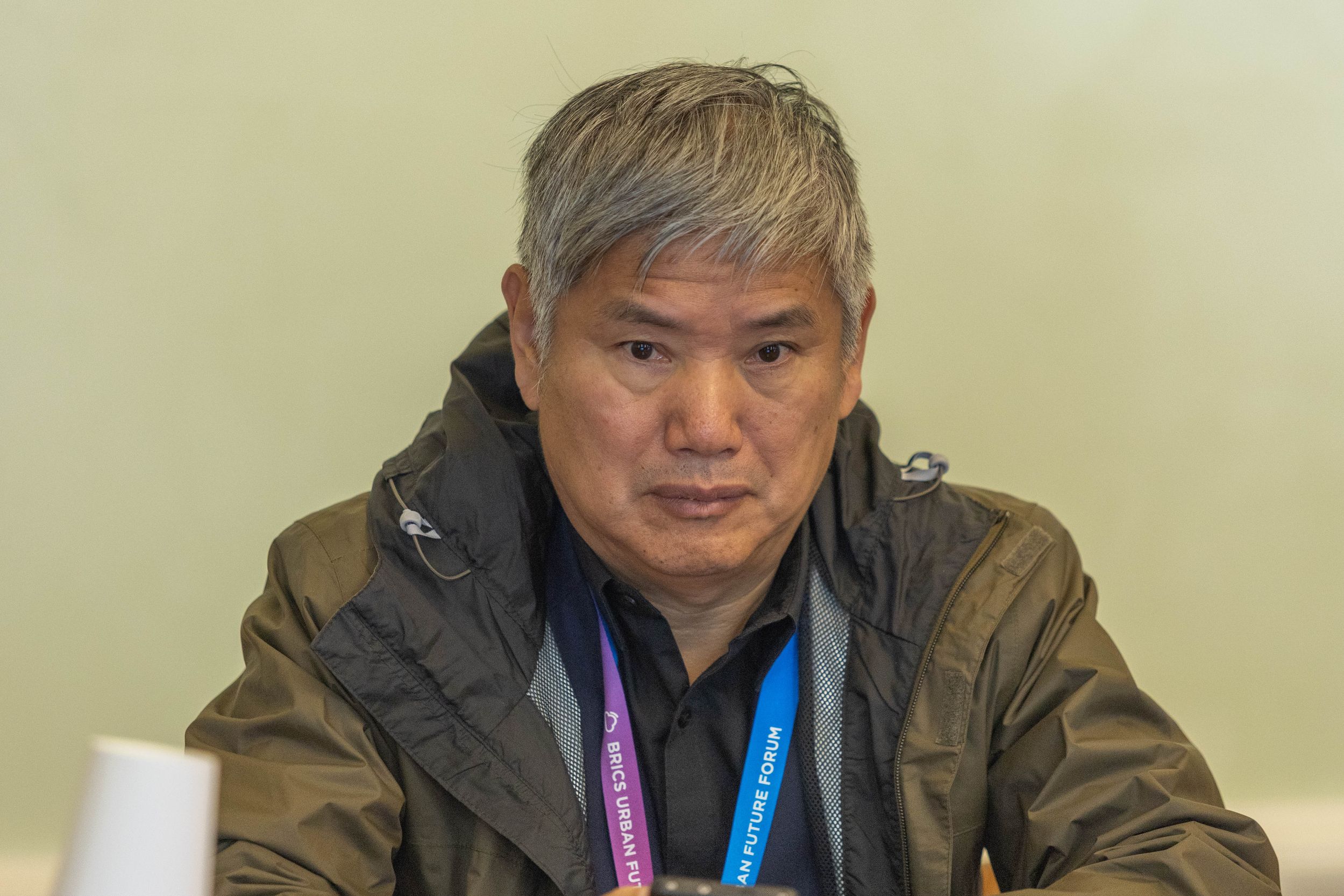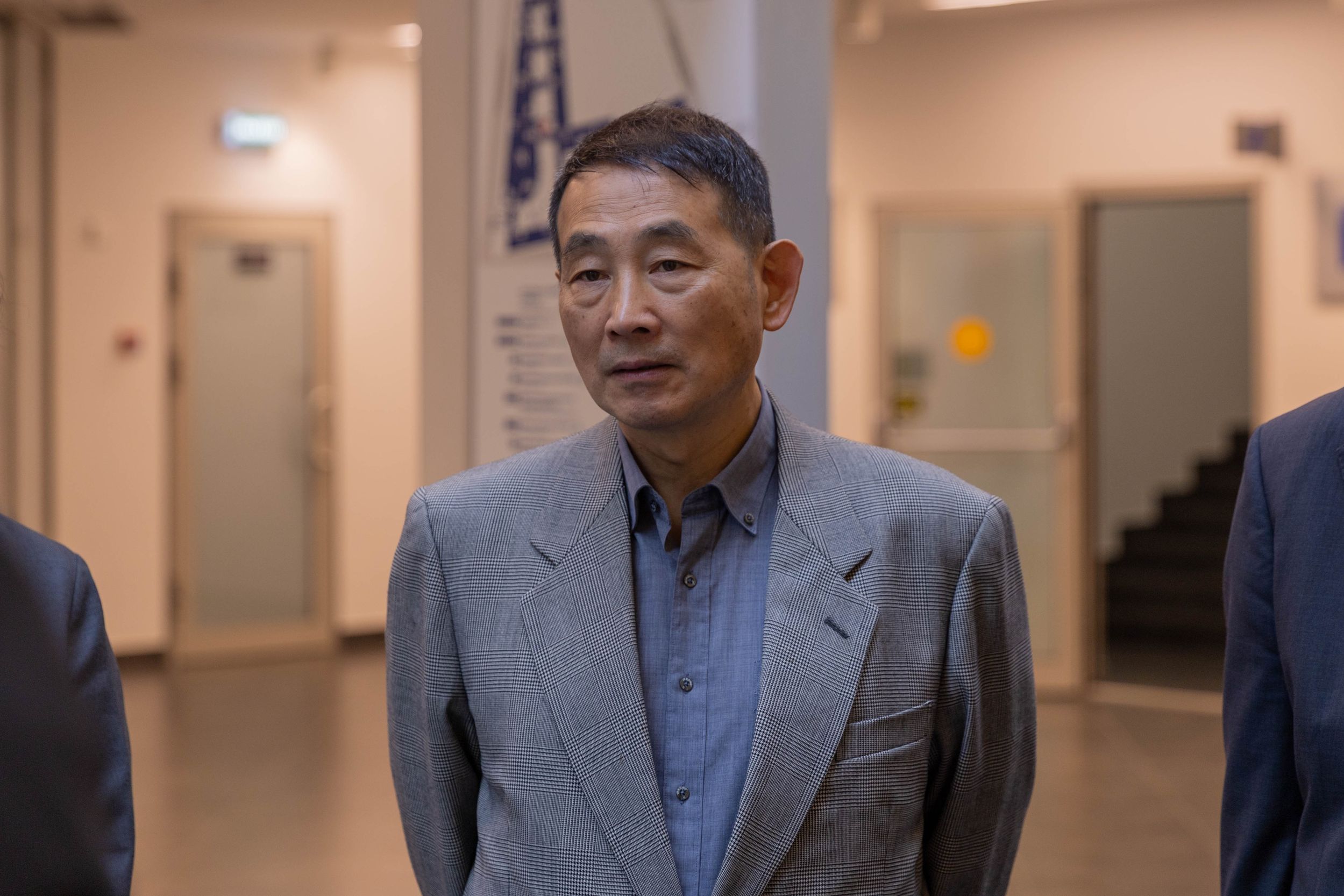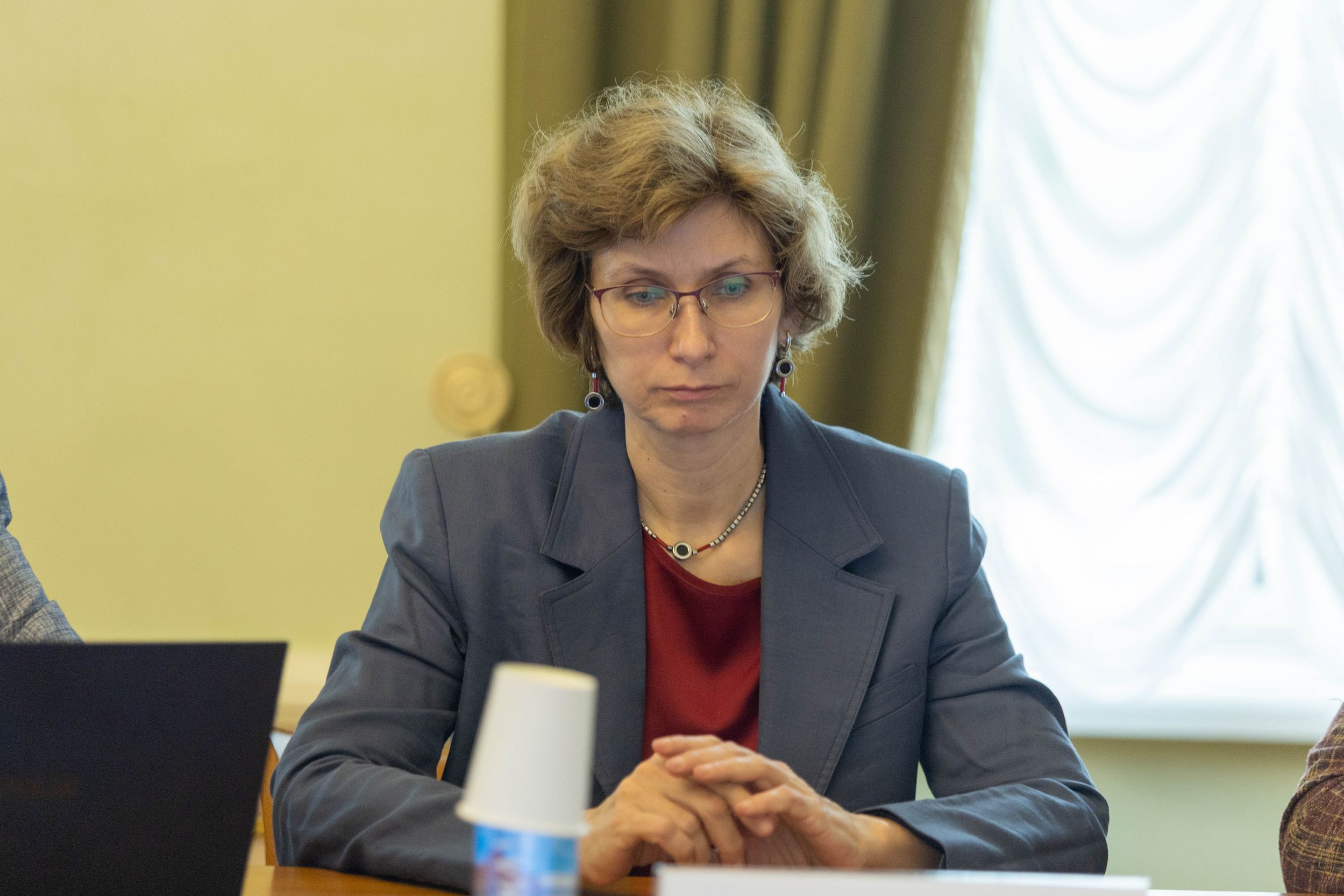International Dialogue on Urban Development: Dynamic Urbanism and Green Infrastructure

In September 2025, the HSE Faculty of Urban and Regional Development (FURD) hosted a delegation of leading scholars and urban development experts from China. Two seminars were held at the Shukhov Lab with the participation of Chinese colleagues: the first focused on green infrastructure, while the second explored the theme of dynamic urbanism. In addition, a meeting between the Chinese delegation and representatives of FURD took place at the university’s main building on Pokrovsky Bulvar. The participants discussed opportunities for expanding cooperation between universities and research centres.
Green Infrastructure
The international seminars opened with a welcoming address by Victoria Khomich, First Deputy Dean and Head of International Affairs at FURD.

‘Today’s event serves as an open discussion platform bringing together international professionals, experts, and FURD students,’ said Victoria Khomich. ‘Our students have the opportunity to ask our distinguished guests direct questions about urban development, tools, and approaches to addressing similar challenges faced by Russia and China in the field of urbanism. Naturally, our countries differ considerably in their approaches to urban development—particularly regarding green infrastructure and dynamic urbanism—but exchanging experience and engaging in professional dialogue is a unique and vital format. It helps to generate new solutions and lay the groundwork for future joint research projects.’
At the seminar on stormwater management and green infrastructure, HSE University was represented by Sergey Sivaev, Professor at the Vysokovsky Graduate School of Urbanism (GSU); Alexander Abdullaev, Senior Lecturer at GSU; and Ekaterina Andreeva, Head of the Joint Department with A101 Group of Urban Planning.
FURD’s Chinese partners also took part in the seminar—among them representatives of Tianjin University, South China University of Technology (SCUT), and the Director of the Board of the Chinese Society for Urban Studies.
The discussion centred on the development and implementation of green infrastructure as part of stormwater drainage systems in Russia and China. It was noted that, on average, only 33.4% of roads in major Russian cities are equipped with traditional stormwater drainage systems. The experts stressed that a separate drainage system with a dedicated network for surface runoff is the most efficient organisational model—one widely adopted in developed countries to ensure comfortable urban mobility, preserve real estate, and prevent flooding risks. They also emphasised the importance of complementing traditional ‘grey’ drainage systems with elements of water–green infrastructure to reduce peak loads and enable rainfall infiltration directly at the point of precipitation.
The seminar also addressed the economic aspects of stormwater management. The cost of maintaining and developing drainage systems in Russia varies by city, averaging around 200,000 roubles per kilometre of network. A lack of unified approaches and diverse management models for system development and maintenance have led to significant differences in actual maintenance costs. Moreover, more than 20 Russian cities have already introduced stormwater drainage tariffs for legal entities owning land plots. The absence of common standards and regulatory gaps in this sector continue to hinder the formulation of a coherent national strategy for urban stormwater management.
The participants put forward several recommendations to help improve the current situation:
developing a regulatory framework for surface water drainage services.
raising public awareness of the importance of green infrastructure.
attracting investment for the modernisation of drainage systems.

Prof. Chen Tian, from the Urban Space and Urban Design Research Institute at Tianjin University and Director of the Tianjin Ecological Engineering Centre for Urban Renewal (TEECUR), presented China’s experience in developing ‘sponge cities.’ According to the Chinese government’s plans, by 2030, 80% of urban areas in major Chinese cities will be able to absorb and reuse up to 70% of rainfall directly where it falls. This approach reduces the load on traditional drainage systems and mitigates damage caused by natural disasters.

Prof. Yu Li, Director of the Board of the Chinese Society for Urban Studies, shared the results of evaluating innovative approaches to sustainable urban development using the example of the Tianjin Eco-City project developed jointly with Singapore. Covering 31.23 square kilometres and home to about 350,000 residents, the complex incorporates several key features:
use of renewable energy sources.
a waste separation and recycling system.
adoption of clean transport technologies.
These measures have produced notable results in reducing environmental impact and improving residents’ quality of life.
Prof. Zhao Miaoxi, Deputy Director of the Department of Urban Planning at South China University of Technology (SCUT), President of the Committee on New Urban Planning Technologies under the Guangdong Spatial Planning Association, and Executive Director of the Guangdong Engineering Research Centre for Smart Urban Planning, outlined the concept of a new model of sustainable urban development using the city of Foshan as an example. The key elements of this approach include:
efficient use of underground spaces.
improvement of the street and road network and transport planning.
active introduction of eco-friendly materials and technologies.
These initiatives help optimise traffic flows, reduce utility costs, and enhance residents’ overall well-being.
Following the seminar, the participants concluded that a comprehensive approach is essential for effective surface water management. They stressed the importance of engaging both the public and the business community in developing green infrastructure, and highlighted the need to expand cooperation, continue joint research, and develop methods for assessing the potential of green solutions.
Dynamic Urbanism
The second seminar featured Prof. Yang Wei, Deputy Dean of the School of Architecture at Tianjin University and co-leader of the joint project with FURD titled ‘Dynamic Urbanism: A Comparative Analysis of Cities with Rapid Population Changes in Russia and China.’ The project, which won HSE University’s 2025 International Academic Cooperation competition, aims to establish a new discipline—dynamic urbanism—focused on studying the patterns of change in cities experiencing rapid growth or depopulation.
According to Nadezhda Zamyatina, Project Lead and Professor at the Vysokovsky Graduate School of Urbanism, many researchers are studying global cities, smart cities, and other popular topics, including urban shrinkage. ‘Our research involves a comprehensive approach aimed at identifying the interconnections between processes associated with growth or depopulation occurring simultaneously in the labour and housing markets, the utilities sector, and the urban environment, as well as in relation to social issues, public sentiment, and urban policy,’ said Nadezhda Zamyatina. ‘The change in technological paradigms, which leads to the decline of some cities and the flourishing of others, is linked not only to technology and the condition of city-forming enterprises—it affects the entire fabric of urban life, and often it is the rigid institutions that have a greater impact on a city’s slide into depopulation than its industrial specialisation as such.’

Prof. Zamyatina expressed hope that exchanging experience with Chinese colleagues would enrich both theoretical and practical approaches to addressing the challenges faced by changing cities. ‘In Russia, the most dramatic transformations traditionally occur in the country’s eastern regions—in resource-based cities—and in many cases, their trajectories resemble those of the old industrial cities in northeast China. The newly established Centre for Arctic and Northern Urban Studies at FURD will serve as a base for this project,’ she said. ‘We plan to explore all factors influencing the development of both growing and declining cities. I believe this will open up new horizons for understanding the challenges these cities face.’
Prof. Yang Wei delivered a presentation titled ‘Urban Dynamics and Sustainable Evolution of the Chinese Building Stocks.’ Her research focuses on sustainable development of building stocks, with a particular emphasis on low-carbon construction and environmentally conscious architectural design. ‘Our team includes urban planners who work on city development, and I would like to tell you about a previous study devoted to the dynamics of urbanisation and the sustainable development of China’s building stock,’ said the professor. ‘We conducted research at various levels of the building and housing stock in the context of sustainable development in the energy sector, as well as on carbon dioxide emissions, environmental protection, and economic issues. The scale ranges from individual buildings to districts, cities and the national level.’
Effective Development of Cities and Countries
The meeting between representatives of HSE University and the Chinese delegation on Pokrovsky Bulvar focused on expanding cooperation between universities and research centres and identifying potential areas for joint academic activity.
Sofia Sadykova, Deputy Head of the HSE International Partnerships Office, spoke in detail about one of the university’s strategic goals—expanding the frontiers of Russian science and education through innovative approaches. ‘HSE University is a large institution with four campuses—in Moscow, St Petersburg, Nizhny Novgorod, and Perm,’ she noted. ‘We also have a fifth, online campus—HSE Online. At present, the university has around 60,000 students, including 6,000 international students.’

Sofia Sadykova also introduced the guests to HSE’s wide range of study areas: ‘Our focus is not limited to the social sciences and economics. We also offer programmes in mathematics, physics, chemistry, biology, and geography. The university includes the Art and Design School and the Film Institute as well.’ HSE offers around 40 English-taught degree programmes and more than 1,000 courses delivered in English.
‘We are one of Russia’s leading research universities, with a strong focus on scientific inquiry, and international cooperation plays a crucial role in this,’ Sofia Sadykova emphasised.
Victoria Khomich, First Deputy Dean and Head of International Affairs at the Faculty of Urban and Regional Development (FURD), presented the faculty’s structure and activities: ‘FURD is an interdisciplinary centre of expertise that addresses a wide range of issues in urban and regional development. We have over 100 experts, 70 lecturers, more than 600 students, and have implemented 50 projects between 2022 and 2024. Our project work covers over 150 cities, and we are always open to international dialogue and new partnerships.’
Konstantin Trofimenko, Director of the HSE Smart City Research Centre, delivered a presentation on cities’ readiness for digital transformation, as well as the technical and economic capabilities required to implement smart city projects. Andrew Borisov, Leading Expert at the HSE Centre for Transport Modelling, spoke about the concept of strategic development of transport infrastructure in Russia and the faculty’s successfully completed projects in this area.
The Chinese delegation expressed gratitude for the warm welcome at HSE University. Nicholas You, Executive Director of the Guangzhou Institute for Urban Innovation, noted that he is already involved in a joint project on the development of high-tech cities and the creation of a city innovation index co-authored by FURD researchers. This work demonstrates how innovative and balanced urban spatial development enables residents to save time and reinvest it in meaningful activities.
‘I am glad we are doing this together—it can contribute not only to the development of specific cities, but also to the growth of our two countries as a whole,’ concluded Nicholas You.
Yang Wei, Deputy Director of the Tianjin Municipal Key Laboratory for Building Environment and Ecological Technology and Deputy Dean of the School of Architecture at Tianjin University, also expressed her gratitude for the opportunity to visit HSE University. She spoke about the joint dynamic urbanism project and student exchange initiatives between the two universities, and proposed further discussions on cooperation.
Liang Chengfa, Chair and President of the Association of Technology Brokers of Suzhou and of the Belt and Road Kunshan International Advanced Technology Institute, added that cities such as Kunshan and Suzhou are eager to collaborate with HSE University. ‘We are interested in working together in various fields—education, science, and student exchange. It would be a great honour for me to welcome your delegation to China in return. We have been partners for several years now, and our cooperation continues to develop dynamically.’
See also:
Scientists Test Asymmetry Between Matter and Antimatter
An international team, including scientists from HSE University, has collected and analysed data from dozens of experiments on charm mixing—the process in which an unstable charm meson oscillates between its particle and antiparticle states. These oscillations were observed only four times per thousand decays, fully consistent with the predictions of the Standard Model. This indicates that no signs of new physics have yet been detected in these processes, and if unknown particles do exist, they are likely too heavy to be observed with current equipment. The paper has been published in Physical Review D.
HSE Scientists Reveal What Drives Public Trust in Science
Researchers at HSE ISSEK have analysed the level of trust in scientific knowledge in Russian society and the factors shaping attitudes and perceptions. It was found that trust in science depends more on everyday experience, social expectations, and the perceived promises of science than on objective knowledge. The article has been published in Universe of Russia.
Institute for Robotics Systems Established at HSE University
As decided by the HSE University Academic Council, a new Institute for Robotics Systems will be established at HSE, and with a strong fundamental base. It will cooperate with relevant departments across the university and engage students and doctoral candidates in research and development (R&D). First Vice Rector of HSE University and Director of the Institute for Statistical Studies and Economics of Knowledge, Leonid Gokhberg, discussed the expected practical results and the framework for cooperation with an industrial partner.
HSE Tops Ranking of Universities Participating in Priority 2030 Programme
The Russian Ministry of Science and Higher Education has published an updated list of participants in the Priority 2030 programme. A total of 106 universities will receive support this year. HSE University was included in the first group and topped the ranking.
HSE Psycholinguists Launch Digital Tool to Spot Dyslexia in Children
Specialists from HSE University's Centre for Language and Brain have introduced LexiMetr, a new digital tool for diagnosing dyslexia in primary school students. This is the first standardised application in Russia that enables fast and reliable assessment of children’s reading skills to identify dyslexia or the risk of developing it. The application is available on the RuStore platform and runs on Android tablets.
HSE Scientists Optimise Training of Generative Flow Networks
Researchers at the HSE Faculty of Computer Science have optimised the training method for generative flow neural networks to handle unstructured tasks, which could make the search for new drugs more efficient. The results of their work were presented at ICLR 2025, one of the world’s leading conferences on machine learning. The paper is available at Arxiv.org.
Physicists Propose New Mechanism to Enhance Superconductivity with 'Quantum Glue'
A team of researchers, including scientists from HSE MIEM, has demonstrated that defects in a material can enhance, rather than hinder, superconductivity. This occurs through interaction between defective and cleaner regions, which creates a 'quantum glue'—a uniform component that binds distinct superconducting regions into a single network. Calculations confirm that this mechanism could aid in developing superconductors that operate at higher temperatures. The study has been published in Communications Physics.
Neural Network Trained to Predict Crises in Russian Stock Market
Economists from HSE University have developed a neural network model that can predict the onset of a short-term stock market crisis with over 83% accuracy, one day in advance. The model performs well even on complex, imbalanced data and incorporates not only economic indicators but also investor sentiment. The paper by Tamara Teplova, Maksim Fayzulin, and Aleksei Kurkin from the Centre for Financial Research and Data Analytics at the HSE Faculty of Economic Sciences has been published in Socio-Economic Planning Sciences.
Larger Groups of Students Use AI More Effectively in Learning
Researchers at the Institute of Education and the Faculty of Economic Sciences at HSE University have studied what factors determine the success of student group projects when they are completed with the help of artificial intelligence (AI). Their findings suggest that, in addition to the knowledge level of the team members, the size of the group also plays a significant role—the larger it is, the more efficient the process becomes. The study was published in Innovations in Education and Teaching International.
New Models for Studying Diseases: From Petri Dishes to Organs-on-a-Chip
Biologists from HSE University, in collaboration with researchers from the Kulakov National Medical Research Centre for Obstetrics, Gynecology, and Perinatology, have used advanced microfluidic technologies to study preeclampsia—one of the most dangerous pregnancy complications, posing serious risks to the life and health of both mother and child. In a paper published in BioChip Journal, the researchers review modern cellular models—including advanced placenta-on-a-chip technologies—that offer deeper insights into the mechanisms of the disorder and support the development of effective treatments.


